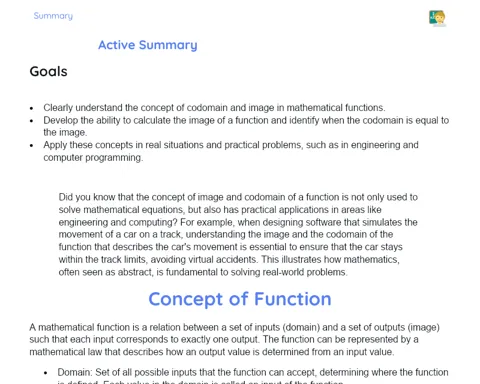Introduction
Relevance of the Theme
Triangles are the basic geometric figures in plane geometry and play a fundamental role in the study of polygons, which in turn are the basis of any composite figure in mathematics. Mastering the concept of triangle congruence is crucial for retaining future topics, such as spatial geometry, Pythagorean theorem, area calculation, analytic geometry, and trigonometry. Congruence is the foundation for mathematical proof and logic, essential skills for advancement in any branch of mathematics.
Contextualization
Within the curricular structure, the study of triangle congruence occurs after the introduction of basic concepts of plane geometry. The student's ability to symbolize, describe, and identify basic geometric properties allows the introduction of a new concept - congruence. By understanding triangle congruence, students will be ready to understand more complex topics later on. Triangle congruence forms the basis for many problem-solving strategies in mathematics, therefore, its proficient understanding is essential for academic success.
Theoretical Development
Components
-
Triangle Congruence: Two triangles are considered congruent if their corresponding sides and angles are equal. Congruence is a fundamental property of geometry and is symbolized by the equivalence symbol, a wavy horizontal line. Through the study of triangle congruence, we are able to develop strategies to prove various properties of triangles, paving the way for solutions to more complex problems.
-
Triangle Congruence Criteria: There are several criteria that we can use to verify whether two triangles are congruent or not. These include SAS (Side-Angle-Side), SSS (Side-Side-Side), ASA (Angle-Side-Angle), AAS (Angle-Angle-Side), and ASA (Angle-Side-Angle). Each of these criteria provides us with a unique way to determine congruence, highlighting the importance of the various properties of triangles.
-
Use of Triangle Congruence in Problem Solving: Triangle congruence is a valuable tool for solving geometry problems. By identifying congruent triangles within a figure, we can infer many additional properties, such as equal angles, equal sides, and so on. This aspect of the study of triangle congruence emphasizes the direct applicability of geometry theory in solving practical problems.
Key Terms
-
Triangle: A polygonal geometric figure with three sides and three angles.
-
Congruent: An adjective applied to two geometric figures that have the same shape and size. In the context of triangles, congruence implies that all corresponding pairs of angles and sides are congruent.
-
Congruence Criteria: Specific requirements that must be met for two triangles to be considered congruent.
-
SAS, SSS, ASA, AAS, and ASA: Acronyms representing different triangle congruence criteria (Side-Angle-Side, Side-Side-Side, Angle-Side-Angle, Angle-Angle-Side, and Angle-Side-Angle, respectively).
Examples and Cases
-
Example of Congruence using SAS Criterion: If we have two triangles ABC and DEF, where AB = DE, ∠ABC = ∠DEF and BC = EF, we can conclude that the triangles are congruent by the SAS criterion.
-
Example of Congruence using SSS Criterion: If, considering the same triangles ABC and DEF from the previous example, we have that AB = DE, AC = DF and BC = EF, we can conclude that the triangles are congruent by the SSS criterion.
-
Example of Congruence using ASA Criterion: Assuming the same triangles ABC and DEF, if ∠ABC = ∠DEF, ∠BCA = ∠EFD and the common side is BC=EF, we can conclude that the triangles are congruent by the ASA criterion.
These examples serve to illustrate the application of the triangle congruence criteria and highlight the importance of mastering these frameworks for solving more complex problems.
Detailed Summary
Relevant Points
-
Definition of Congruence: The congruence of triangles is a special equivalence between triangles, with two triangles being congruent if all their corresponding sides and angles are equal.
-
Importance of Congruence: The congruence of triangles is a fundamental property in geometry, forming the basis for various problem-solving strategies. It is essential in solving complex geometric problems and in proving mathematical properties.
-
Congruence Criteria: There are several criteria for testing the congruence of triangles, such as SAS, SSS, ASA, AAS, and ASA. Each criterion emphasizes different congruent properties of triangles, demonstrating the diversity and richness of the concepts involved in congruence.
-
Use of Congruence in Problem Solving: The congruence of triangles is not just a theoretical concept, but a practical tool for solving geometry problems. Identifying congruent triangles within a figure allows us to infer many other properties, significantly simplifying problem solving.
Conclusions
-
Congruence Implies Identity: The study of triangle congruence illustrates that two figures that are congruent are essentially identical. This means that all their corresponding angles and sides are equal, an extremely powerful property.
-
Applicability of Theory: The congruence of triangles is not an isolated concept, but an essential contributor to solving a wide range of geometry and mathematics problems.
-
Proof by Congruence: The congruence of triangles is one of the main tools for proving the equality of various geometric figures. The use of congruence criteria in a proof demonstrates a high level of understanding and application of mathematical principles.
Exercises
-
Exercise 1: Given triangle ABC, with ∠ABC = 50°, AC = 5cm. Let point D be on segment AC such that AD = 3cm. Construct a triangle ADE congruent to ABC by SAS.
-
Exercise 2: Given triangles PQR and QST, where ∠P = ∠Q = ∠R and PS = PT = PR. What congruence criteria can be used to prove that triangles PQR and QST are congruent?
-
Exercise 3: On a city map, there is a triangular park with sides measuring 200m, 250m, and 350m. In another location on the map, there is an empty plot whose sides measure 200m, 250m, and 350m. Can we conclude that the plot has the same shape as the park? Why?
These exercises aim to solidify the understanding of congruence criteria and apply these criteria in different contexts, preparing students for more complex congruence resolution problems.



